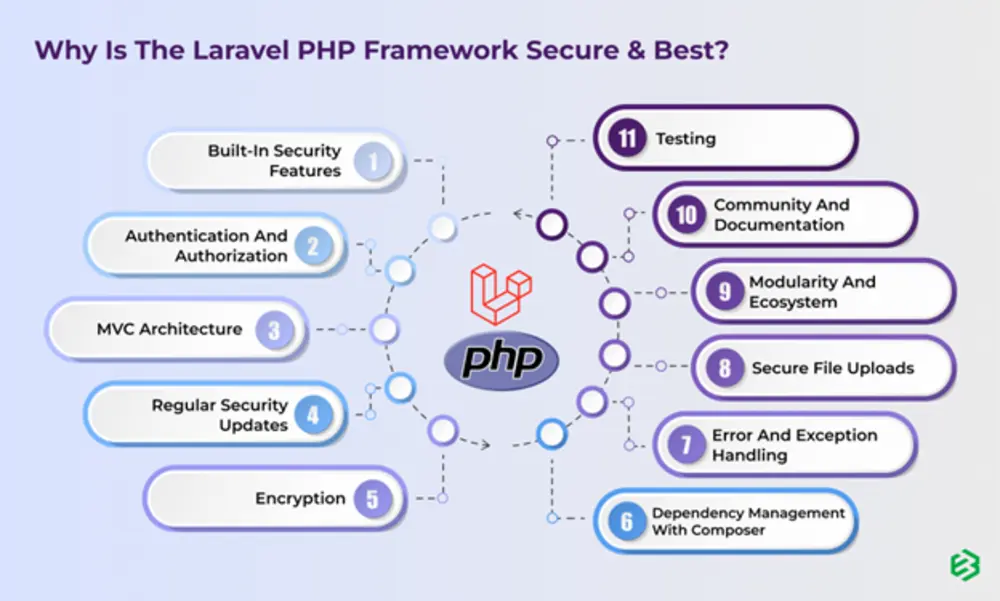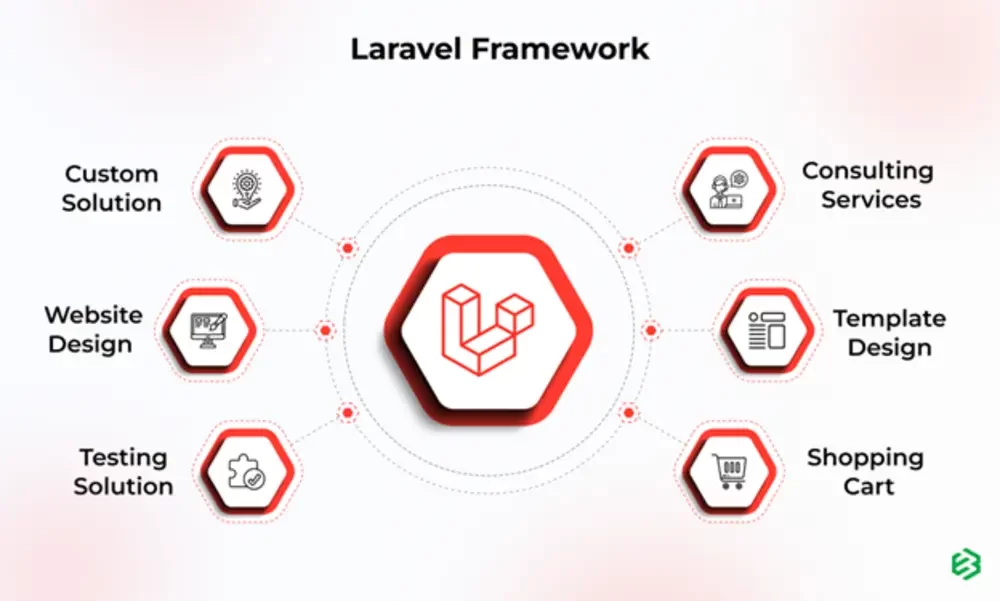Laravel is a free, PHP language-based server-side or back-end security framework, used to build websites and applications. Taylor Otwell first developed the framework in 2011 and it has evolved with many features that make it convenient and popular for coders. More than two million sites use the framework, and it has a 35%+ share of the market. Some leading sites using Laravel are Invoice Ninja, Barchart, and AlphaCoders.
Security frameworks cover risk and threat management, cyber security threats, and vulnerabilities. Organizations that use these frameworks are resilient to cyber-attacks. Security frameworks are the rules, policies, and standards released by organizations such as Homeland Security, the National Institute of Standards and Technology, and ISO 27001.
Security frameworks have access control, protection of data, and identification of important assets, systems, and vulnerabilities. The architecture allows easy maintenance of code and linking of new technologies such as AI. This blog examines reasons for recommending Laravel to build secure web systems.
Features of Laravel

Laravel has several features for creating secure applications. The features are:
Security features
Laravel has many inherent features as a part of the architecture. In the Cross-Site Request Forgery – CSRF feature, Laravel creates a token when forms are submitted. If the form is forged by a hacker then it will not have secure tokens, and the request is not considered. Laravel does not allow harmful code to be injected into SQL queries. As a result, hackers cannot place harmful SQL statements that can destroy the repository of data.
Laravel gives protection against cross-site scripting or XSS. In XSS, hackers place malicious Javascript code in browsers when users visit a site. Laravel prevents such code from running in the browser on the site.
Authentication
Laravel has a secure gate and policy feature that controls authentication. The feature is included inside the framework with authentication scaffolding. User names, IDs, registration, and passwords can be easily set up. The role-based access control allows users with certain designations to access some features of websites. Attacks of site brute force methods are stopped by rate limiting.
Laravel prevents passwords from getting stolen by using password hashing. In this process, passwords are converted and encrypted to strings by using an algorithm called Bcrypt and Argon2. These strings cannot be reverse-engineered. Even if the hacker has the password, multi-factor authentication prevents misuse.
MVC – Model as view architecture
The architecture of Laravel is of MVC type with model, view, and controller components. The model manages the tasks of communicating with the database and bundling variables, and functions and links them in a single class of programming that is object-oriented. As a result, users cannot interact with data directly, but through specified routines, ensuring higher security and control.
Laravel uses Eloquent Object Relational Mapping and Create, Read, Update, Delete – CRUD on data. Since relations between models are defined, complex data interactions are managed with less code. In Laravel, Views are coded with a template engine called Blade. The result is reusable UI components with compact syntax. Laravel has a Controller that communicates between the View and the Model. This feature increases the security of data modification and use.
Project environment
The Laravel project environment is considered secure for all components in a controlled environment. Some of these components are the .env file, environment detection, configuration files, caching configuration, and a development environment. Several tools such as Laravel Homestead, Docker, Composer, and Nimbus are included within the development environment.
All assets in the Laravel application environment are protected by protection for input validation, hashing of passwords, CSRF, and XSS. When variables are managed correctly, security updates are applied, and secure coding helps to increase the security of the application development environment. Data and parameters are bound with Eloquent ORM, an object relational mapper tool. Other features such as session management, encrypted cookies, and validation further increase the security.
Database migrations
Laravel allows secure sharing of the database schema. Changes, additions of columns, and new definitions to be done with PHP code and SQL code are not needed. The schema face allows table creation and manipulation in a controlled environment. It is also possible to squash unwanted or extra migration to a SQL file. This feature allows bloated databases with excessive data to be trimmed and stored securely.
The Laravel schema builder allows the creation, and changing of the order of migrations securely. If the application is to be migrated on several servers, then the isolate command ensures secure and independent migration. It is also easy to roll back a migration securely and ensures that the last version is put in place.
Secure libraries
Laravel has several secure libraries to build applications. Some libraries are Intervention/image, spatie/laravel-media library, Laravel Livewire, Socialite, Laravel Solr, PHPStan, and others. External parties provide libraries, and they can have vulnerabilities that allow hackers to access the application. Developers can also use other tools to code, and these can have issues.
Built-in security features of Laravel prevent malicious code from running and harming the applications. Some features are robust authentication, protection against several hacking methods, session security, and encrypted tokens. These features help in overcoming any malicious code. Code hygiene and good coding methods further increase security. Regular patch updates, and testing, are essential for safety.
Artisan CLI
Laravel uses the Artisan CLI command line interface provided by the Symfony Console component. It has several commands that help in building the application. While it has several security features, it allows customization of applications. Several tasks such as migration, configuration, and writing code to increase security are run with Artisan CLI.
In Laravel, the Artisan CLI is used to control encryption and key generation. The key is applicable for all the encrypted values. There is no need for developers to use other tools and they can produce the keys through the command line interface. It also stops destructive commands from running and verifies dependencies that have known vulnerabilities. A report card with the number of checks passed, skipped, and failed is given.
Future development
The use of Laravel is expected to continue in 2025 and beyond. Several features such as good syntax, support for rapid development, high inherent security, scalability, a large community of users, good documentation, increased capabilities of APIs, single page apps, and headless CMS promise continued use.
Laravel is used in multi-language sites, for microservices, serverless architecture, artificial intelligence, and machine language applications. Since the components can be reused in the project, the development speed is increased. It is free and hence the cost of tools is reduced. These and other features make it suitable for futuristic development.
Conclusions
The review examined several features of Laravel that make developers recommend it for secure and futuristic development. It has several important features and functionalities that developers use for building highly functional and secure sites. Some features discussed include anti-cross-site request forgery, SQL injection, cross-site scripting attacks, and others. The structure is such that external malicious scripts do not interact with data.
These features of Laravel provide the means for developers to build a secure framework. Findings also indicate that Laravel will continue to be used in the future for several types of applications. Hence, the conclusion is that several inherent features of Laravel have made developers recommend the best PHP framework for secure and futuristic development.
Laravel has a well-structured authentication system. As a result, used IDs are protected, and role-based access can be given. Security features such as password hashing, rate limiting, and multi-factor authentication are provided. Laravel uses the MVC architecture with separate and linked components model, view, and controller. These components present higher security for applications created with L. Other features are EORM, and CRUD that enhance safety.
Author Name:- Harikrishna Kundariya
Biography:- Harikrishna Kundariya, a marketer, developer, IoT, Cloud & AWS savvy, co-founder, Director of eSparkBiz Technologies. His 14+ years of experience enables him to provide digital solutions to new start-ups based on IoT and SaaS applications.
